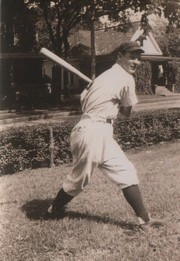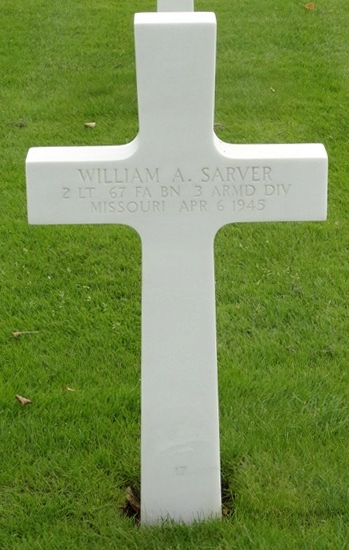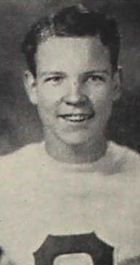Bill Sarver
| Date and Place of Birth: | January 31, 1920 Kansas City, MO |
| Date and Place of Death: | April 6, 1945 near Halle, Germany |
| Baseball Experience: | Minor League |
| Position: | Outfield |
| Rank: | Second Lieutenant |
| Military Unit: | 67th Field Artillery Battalion, 3rd Armored Division US Army |
| Area Served: | European Theater of Operations |
Bill Sarver was a young outfielder drawing comparisons with the great Joe DiMaggio. But military service in Europe would see his life end just one month before the war against Germany ended.
William A. Sarver was born in Kansas City, Missouri, on January 31,
1920. He attended Central High School in Kansas City where he was
recognized as an outstanding baseball player. At the age of 17, and
making a name for himself playing third base for Lapetina of the Ban
Johnson League, Sarver attended a New York Yankees tryout camp. There
were 500 attendees at the camp; Sarver and future Yankees catcher Ralph
Houk were among the seven who received a contract with the American
League club and he was assigned to the Joplin Miners of the Western
Association.
Sarver joined the Neosho Yankees of the Class D
Arkansas-Missouri League for 1938. He got off to a slow start and by
mid-June he was batting only .192 (15 for 78) and had a fielding
percentage at third base below .800. But as the summer progressed the youngster found
his stride and finished the season batting .254 over 94 games, although
he made 41 errors. In 1939, Sarver was back with Neosho,
and manager Dennis Burns, who was with the Philadelphia Athletics in the
mid-1920s, moved the fleet-footed 19-year-old to center field. He
responded by hitting .284 in 123 games and led the league with 40
doubles and 48 stolen bases. Teammate Ralph Houk also had a strong season
batting .313 and playing solid defense behind the plate.
Sarver began 1940 with the Akron Yankees of the Class C Mid-Atlantic League but was optioned to the Amsterdam Rugmakers of the Class C Canadian-American League on May 4. He made an immediate impact the following day in a pre-season exhibition game at Mohawk Mills Park. Playing in right field against Ithaca College, he hit a triple and handled three chances, one a difficult catch up against the outfield fence. Both offensively and defensively he continued to impress. "If you know of a smoother all-around performer than Bill Sarver, the Rugmakers' centerfielder," wrote sports editor Jack Minnoch of the Amsterdam Evening Recorder in June 1940, "we have our best ear cocked to catch the name."
By July, he was hitting .333 (seventh best in the league), although
he tailed off as the season progressed and finished the year with a .287
average, 10 home runs and 67 RBIs over 119 games. He was optioned to
Norfolk of the Piedmont League in September, but began the 1941 season
with the Augusta Tigers of the Class B South Atlantic League. Sarver was
only with the team for a little over a month but that time resulted in a
reunion with Ralph Houk, and the young catcher introduced Sarver to local
girl Marian Smith. They married in Kansas City on December 8,
1942.
Sarver joined the Akron Yankees of the Class C Mid-Atlantic League in
late May but failed to hit consistently - batting just .210 in 54 games -
and found himself back with the Rugmakers for the latter part of the
season where he batted .226 over 41 games, but received honorable
mention on the Canadian-American League all-star team.
Sarver was 21 years old and
had completed four seasons in the minors. But his career was now on hold
as he entered military service with the Army on November 3, 1941.
Initially stationed at Fort Bragg, North Carolina, Sarver
was selected for Officer Candidate School at Fort Sill, Oklahoma, and
was commissioned a second lieutenant in November 1942.
In January 1945, Sarver bid farewell to Marian and his young
daughter, Kathleen (William, a son would be born in September 1945), and departed for Europe with the 67th
Field Artillery Battalion, 3rd Armored "Spearhead" Division. The
division broke through to the Rhine River and captured Cologne on March
7, 1945. Two weeks later it crossed the Rhine and moved north to capture
Paderborn on April 1. The 3rd Armored then pushed on against
disorganized resistance. On April 6, 1945, Second Lieutenant Sarver was
serving as a forward observer when he was killed by small arms fire. He
was buried at the Netherlands American Cemetery in Maargraten, Holland.
Sarver was posthumously awarded the Silver Star, which was presented to
his wife and children at Fort Gordon, Georgia.
|
Team |
League |
Class |
G |
AB |
R |
H |
2B |
3B |
HR |
RBI |
AVG |
|
| 1937 | Joplin | Western Assoc | C | - | - | - | - | - | - | - | - | - |
| 1938 | Neosho | Arkansas-Missouri | D | 94 | 331 | 57 | 84 | 9 | 4 | 4 | 48 | .254 |
| 1939 | Neosho | Arkansas-Missouri | D | 123 | 476 | 113 | 135 | 40 | 8 | 4 | 61 | .284 |
| 1940 | Amsterdam | Canadian-American | C | 119 | 498 | 91 | 143 | 24 | 11 | 10 | 67 | .287 |
| 1941 | Augusta | South Atlantic | B | 26 | 104 | 16 | 22 | 4 | 2 | 0 | 9 | .212 |
| 1941 | Akron | Mid-Atlantic | C | 54 | 200 | 26 | 42 | 7 | 1 | 0 | 22 | .210 |
| 1941 | Amsterdam | Canadian-American | C | 41 | 177 | 31 | 40 | 8 | 0 | 2 | 15 | .226 |
 |
 |

Bill Sarver's grave at the Netherlands American Cemetery in Maargraten, Holland
Source
Amsterdam Evening Recorder, May 6, 1940
Amsterdam Evening Recorder, June 13, 1940
Amsterdam Evening Recorder, July 6, 1940
Amsterdam Evening Recorder, September 2, 1941
Amsterdam Evening Recorder, December 10, 1941
Thanks to Robert, Don, Mary, Eleanor and Patricia Sarver for their help with this biography. Thanks, also, to Bill Sarver, Jr. Thanks to Astrid van Erp for help with a photo for this biography.
Date Added February 15, 2012 Updated August 3, 2017
Baseball's Greatest Sacrifice is associated with Baseball Almanac
Baseball's Greatest Sacrifice is proud to be sponsored by




